You know the question I get all the time? It’s not about finding the perfect ergonomic chair or the best task lighting, though those are important. It’s some version of this: “River, my whole house feels… chaotic. I can’t focus, I can’t relax. Where do I even start?” And my answer usually surprises them: Let’s talk about your kitchen.
Most of us see the kitchen as a chore zone. A place for cooking, cleaning, and accumulating clutter. But it’s the heart of your home, and its energy bleeds into every other room. A kitchen that’s wasteful, inefficient, and full of harsh chemicals doesn’t just drain your wallet; it drains your mental energy. A “green” kitchen isn’t about being a perfect eco-warrior. It’s about creating a space that runs so smoothly and healthily in the background that it gives you back your time, money, and peace of mind. It becomes a foundation for calm, not a source of stress. So let’s walk through it, the real way.
Foundational Green Choices: Planning Your Eco-Friendly Kitchen
This is the part everyone wants to skip. Don’t. A little thinking upfront saves you so much time, money, and regret later. This isn’t about drawing up blueprints; it’s about getting honest about what you have and deciding where to focus your energy for the biggest payoff.
1. Assess Your Kitchen’s Eco-Footprint: Identify Key Areas for Greening Efforts
Okay, “eco-footprint” sounds intimidating. Forget that. Let’s call this a “Reality Check.” The real point here is to stop guessing and start knowing where your money and energy are actually going. It’s about finding the silent drains on your resources. The biggest culprits are almost always hiding in plain sight: ancient appliances that guzzle electricity and the mountain of food you throw out.
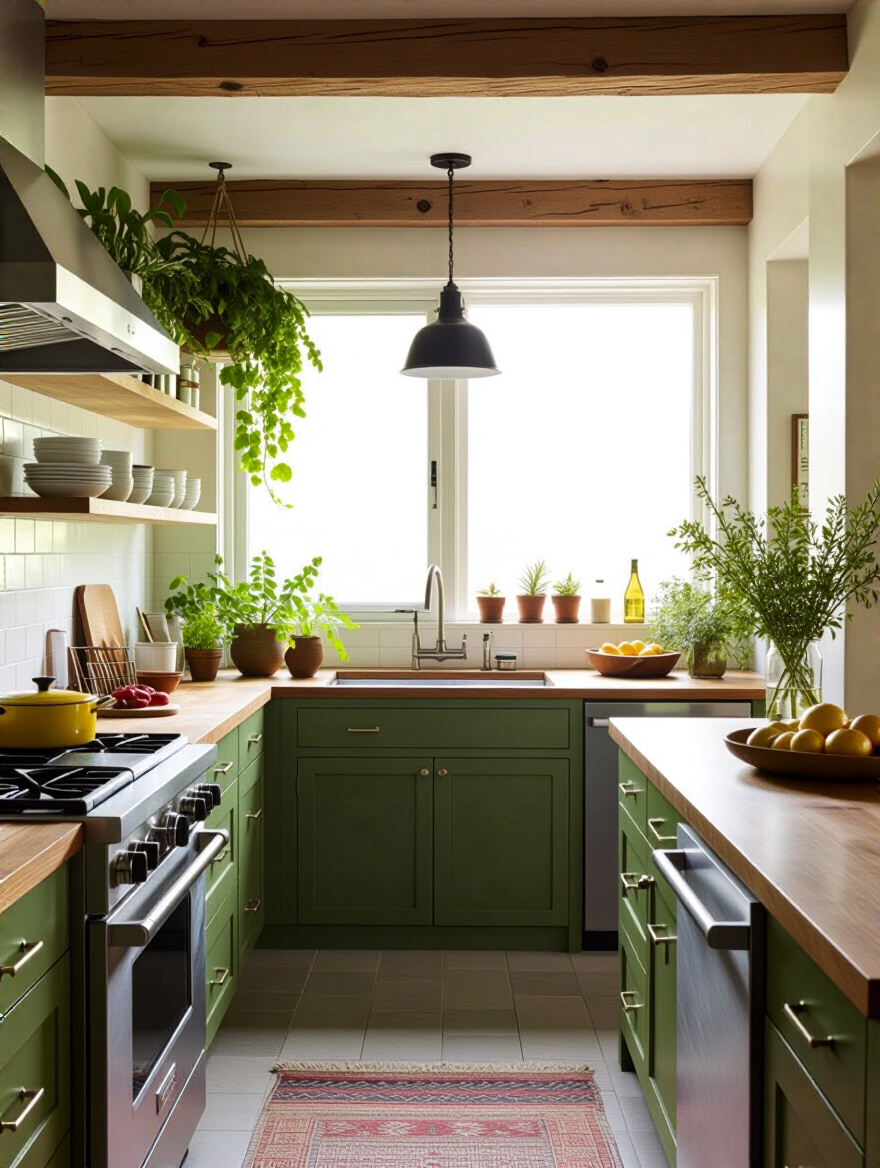
I once had a client who was stressed about her bills. She was convinced her new TV was the problem. I had her buy a cheap Kill-A-Watt meter and plug it into her 15-year-old fridge for a day. Boom. That one appliance was costing her over $30 a month. That’s the kind of data you want. You don’t know what to fix until you know what’s broken. Do a quick audit of your appliances (how old are they?) and your trash (what are you really throwing away?). It’s five minutes of work that will literally tell you where the treasure is buried.
Once you have that data, you’ll know exactly where to aim your efforts to get the best results. Which brings us to our next point.
2. Define Green Priorities: Focus on High-Impact Changes for Sustainable Living
Here’s the thing: trying to do everything at once is a recipe for doing nothing at all. You’ll get overwhelmed and give up. After your Reality Check, you’ll probably have a list of a dozen things you could do. The secret is to ignore most of them. Pick the two or three things that will make the biggest dent. This is about being strategic, not exhaustive.
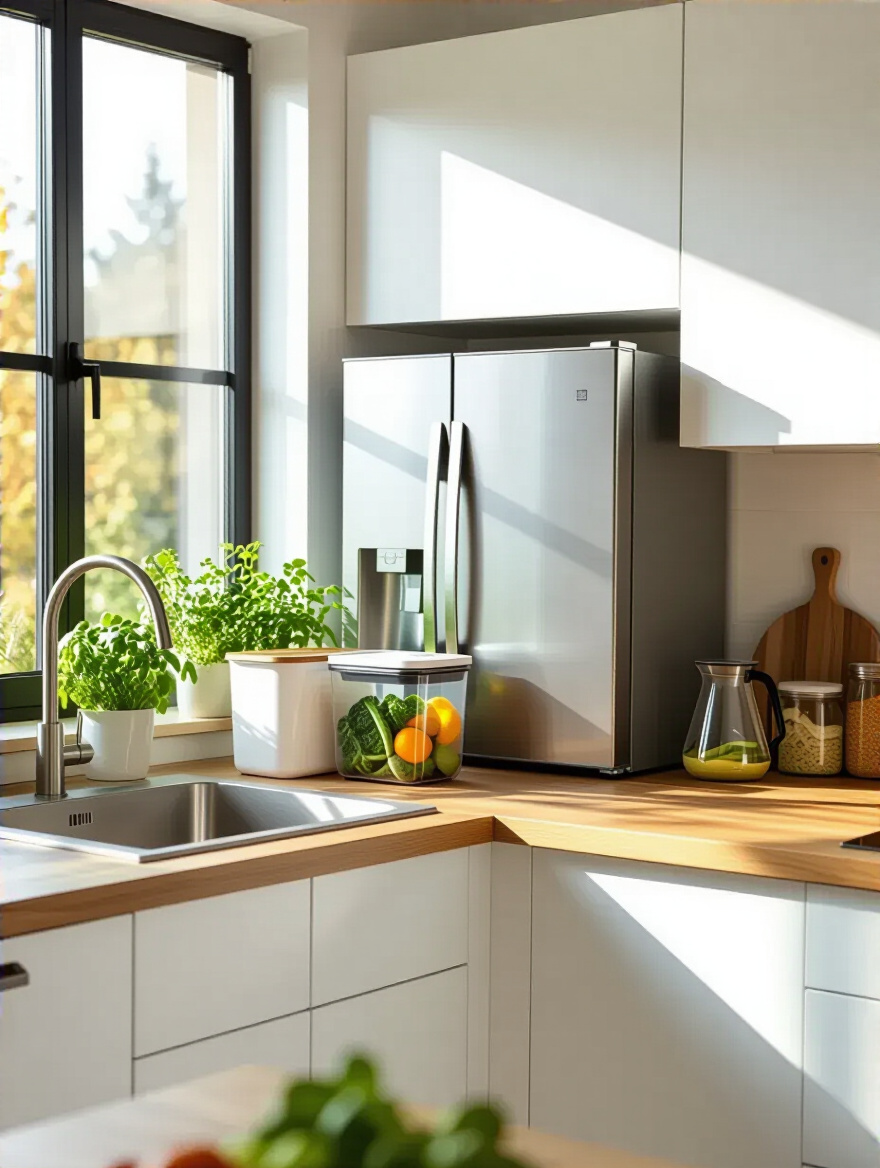 Sustainable Kitchen highlighting high-impact changes like efficient appliances, waste-sorting bins, and water-saving fixtures.” class=”wp-image-2266″/>
Sustainable Kitchen highlighting high-impact changes like efficient appliances, waste-sorting bins, and water-saving fixtures.” class=”wp-image-2266″/>For most people, the biggest wins are almost always the same: replacing that ancient, energy-sucking refrigerator and getting a handle on food waste. Seriously. That’s it. A new ENERGY STAR fridge can save you hundreds over its life, and the average family throws away over a thousand dollars in food every year. The BS everyone tells you is that you need to install solar panels and a gray water system to be “green.” That’s noise. The real impact is in the boring, everyday stuff. Follow the ‘Worst First’ Rule: fix your single most inefficient appliance and tackle your biggest source of waste. You’ll see a bigger change from that than from a dozen smaller “green” purchases combined.
With your priorities set, it’s time to figure out which products are actually worth your money.
3. Explore Eco-Certification Labels: Confidently Choose Truly Sustainable Products
Navigating the world of “green” products feels like a scam sometimes, right? “Eco-friendly,” “natural,” “earth-kind”… most of these words are meaningless marketing fluff. This is where labels come in. Think of them as your cheat sheet. Instead of doing hours of research yourself, you let a third-party organization with actual scientists do the work for you.
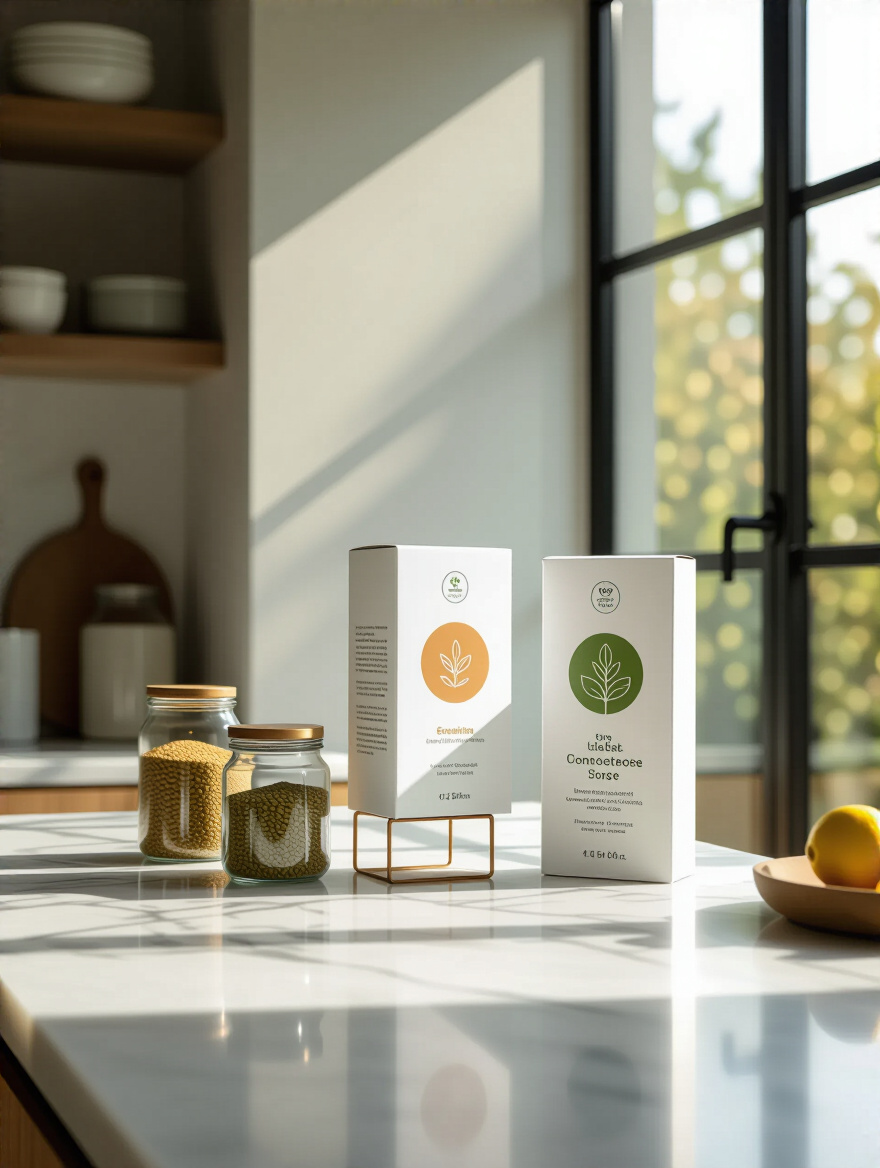
You don’t need to memorize them all. Just know the big ones:
- ENERGY STAR: For appliances. Means it’s a top performer in energy efficiency. A total no-brainer.
- WaterSense: For faucets and dishwashers. The same idea, but for water savings.
- FSC (Forest Stewardship Council): For anything made of wood, like cabinets or countertops. It means the wood was harvested responsibly, not clear-cut from an ancient forest.
- GREENGUARD Gold: For paints, finishes, and furniture. This means it won’t be off-gassing nasty chemicals (VOCs) into the air your family breathes.
I used to think this was all overkill. Then a client installed “eco-friendly” cabinets that weren’t certified, and the chemical smell gave her headaches for a month. The shortcut is to look for these logos. If a product has one of these, it’s legit. If it just has a green leaf and a fuzzy marketing word, be skeptical.
Knowing about labels helps with new stuff, but the biggest gains often come from dealing with what you already have.
4. Conduct a Waste Audit: Target Major Reduction Opportunities in Your Kitchen
I know, this sounds gross. But I promise you, this is the single most enlightening thing you can do for your home. For one week, just pay attention to what goes into your trash and compost. You don’t even have to weigh it—just notice. How many half-empty jars of pasta sauce? How much wilted spinach? How much plastic packaging from snacks?
We all have a massive blind spot when it comes to our own waste. We think we’re doing pretty well. We’re not. The first time I did this, I was mortified. I thought I was a master of using up leftovers, but the sheer volume of forgotten produce at the back of the fridge was a wake-up call. It’s not about guilt. It’s about information. Seeing that pile of plastic wrap or those specific food items you always buy and never use is the key to creating an actionable plan. You can’t solve a problem you can’t see.
This one step will almost certainly change how you shop and save you a surprising amount of money.
5. Plan for Resource Efficiency: Strategize Energy and Water Savings Upgrades
Alright, let’s talk about future-proofing. When you do decide to upgrade something—whether it’s a faucet or a whole dishwasher—it’s your chance to lock in years of savings. Don’t just look at the price tag. That’s the amateur move. Think about the lifetime cost. A cheap dishwasher might save you $100 today but cost you an extra $30 a year in electricity and water for the next ten years. You didn’t save money; you just deferred the payment.
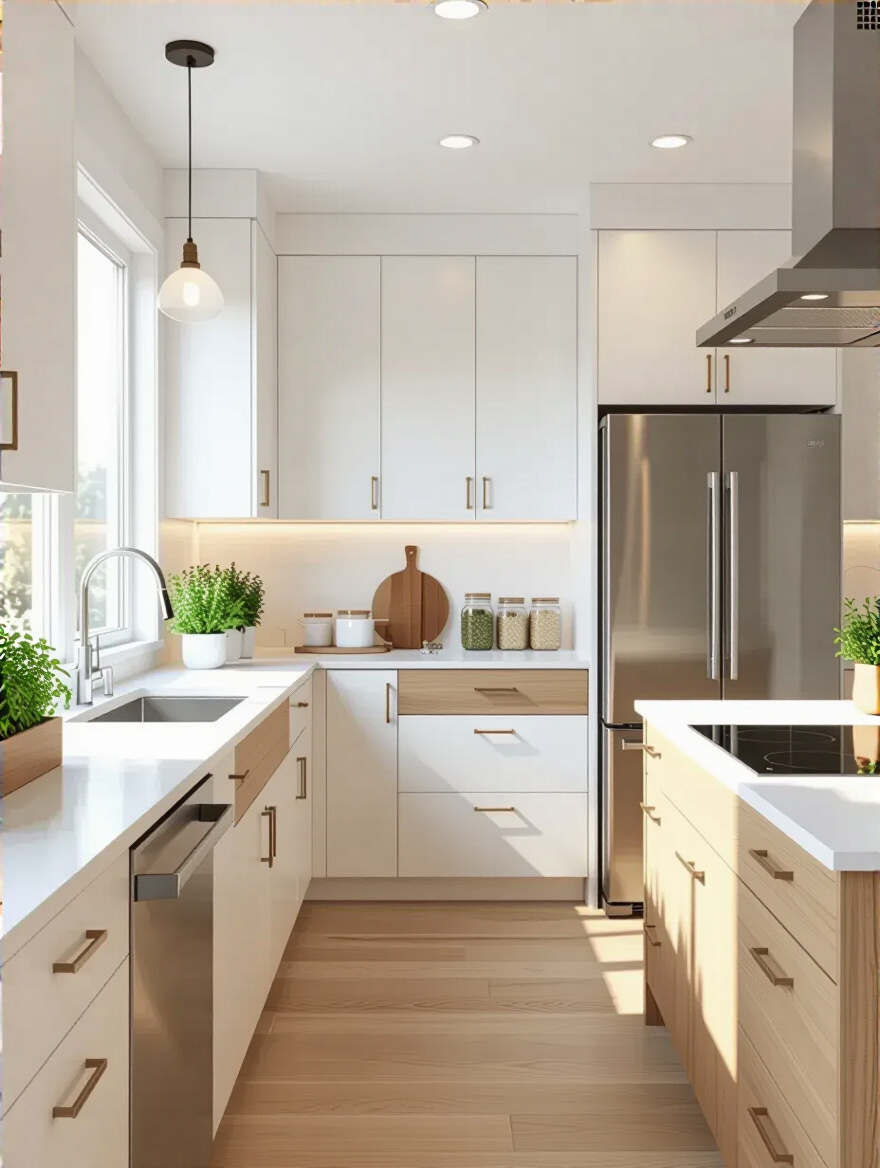
This is where you look for those ENERGY STAR and WaterSense labels we talked about. This is where you might choose a faucet with a pause button, which is amazing for saving water while you’re scrubbing a pot. It’s about making choices now that will work for you on autopilot for years to come. It’s designing a system that’s inherently efficient, so you don’t have to think about it every single day.
Now that we’ve laid the groundwork, we can get to the more tangible parts of building a better space.
Sustainable Design & Materials: Building a Greener Space
This is where we talk about the stuff your kitchen is actually made of. The choices here affect not just the planet, but the health, mood, and feel of your home every single day.
6. Maximize Natural Light: Reduce Reliance on Artificial Lighting Dramatically
Before you spend a dime on fancy light fixtures, look at your windows. Natural light is the ultimate luxury, and it’s free. A kitchen flooded with daylight feels more open, more energizing, and cleaner. It’s also a massive energy saver. Relying on sunlight means you’re not flipping on switches and burning electricity all day long.
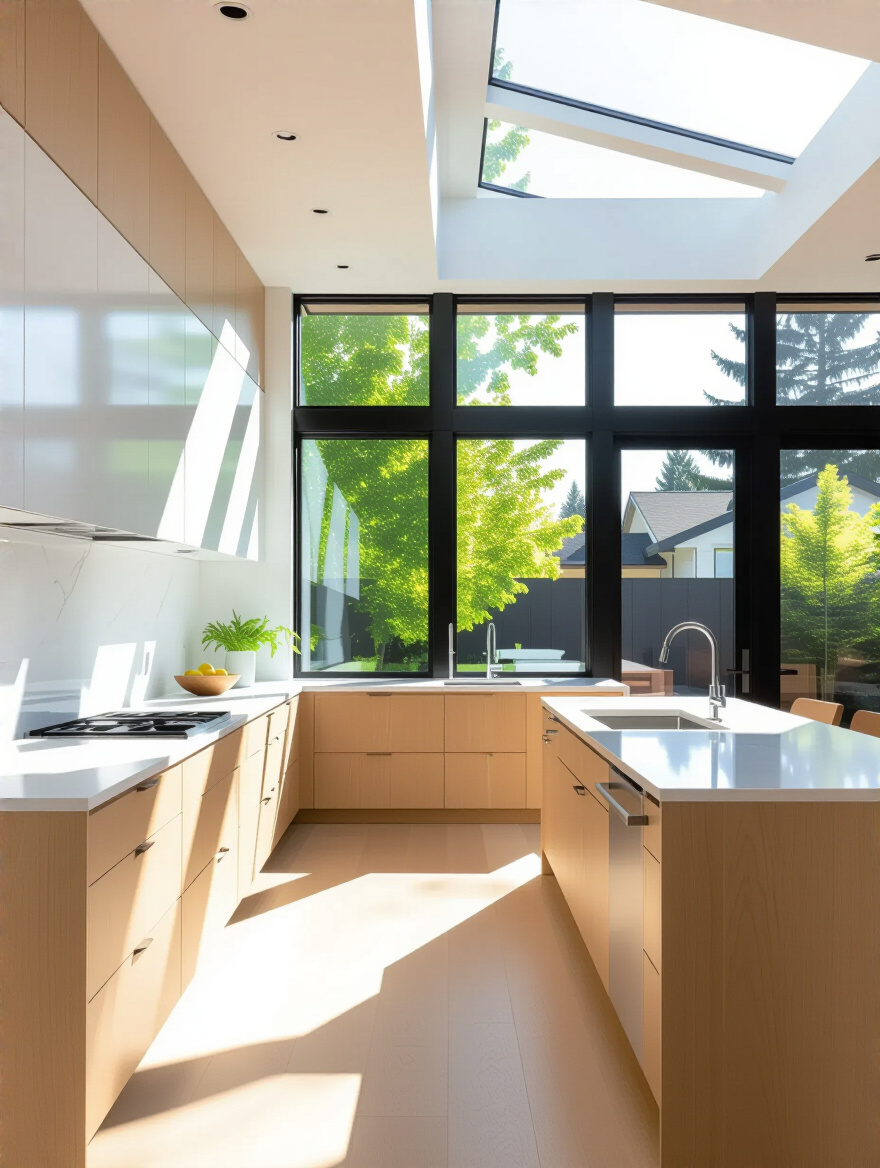
The simplest fix is often just rethinking what’s in front of your windows. Do you have heavy, dark curtains? A giant toaster oven blocking the best light? Swap them out. Paint your walls a lighter, more reflective color. A can of white paint can do more to brighten a room than a hundred-dollar light fixture. A friend of mine simply moved a tall shelving unit from one wall to another, unblocking a window, and it completely transformed the feel of his kitchen from a cave into a cheerful workspace.
Having great light reduces eye strain and can even boost your mood. It’s one of those foundational things that makes a space feel good to be in.
7. Choose Recycled & Upcycled Materials: Inject Unique Charm, Minimize Landfill Waste
This is where you can have some fun and save a ton of money. Not everything in your kitchen needs to be new and slick. Using reclaimed materials is the ultimate win-win: you divert stuff from a landfill, save money, and get a piece with a story. Think reclaimed barn wood for open shelves, a countertop made from recycled glass bottles, or a kitchen island built from a cool old industrial cart.
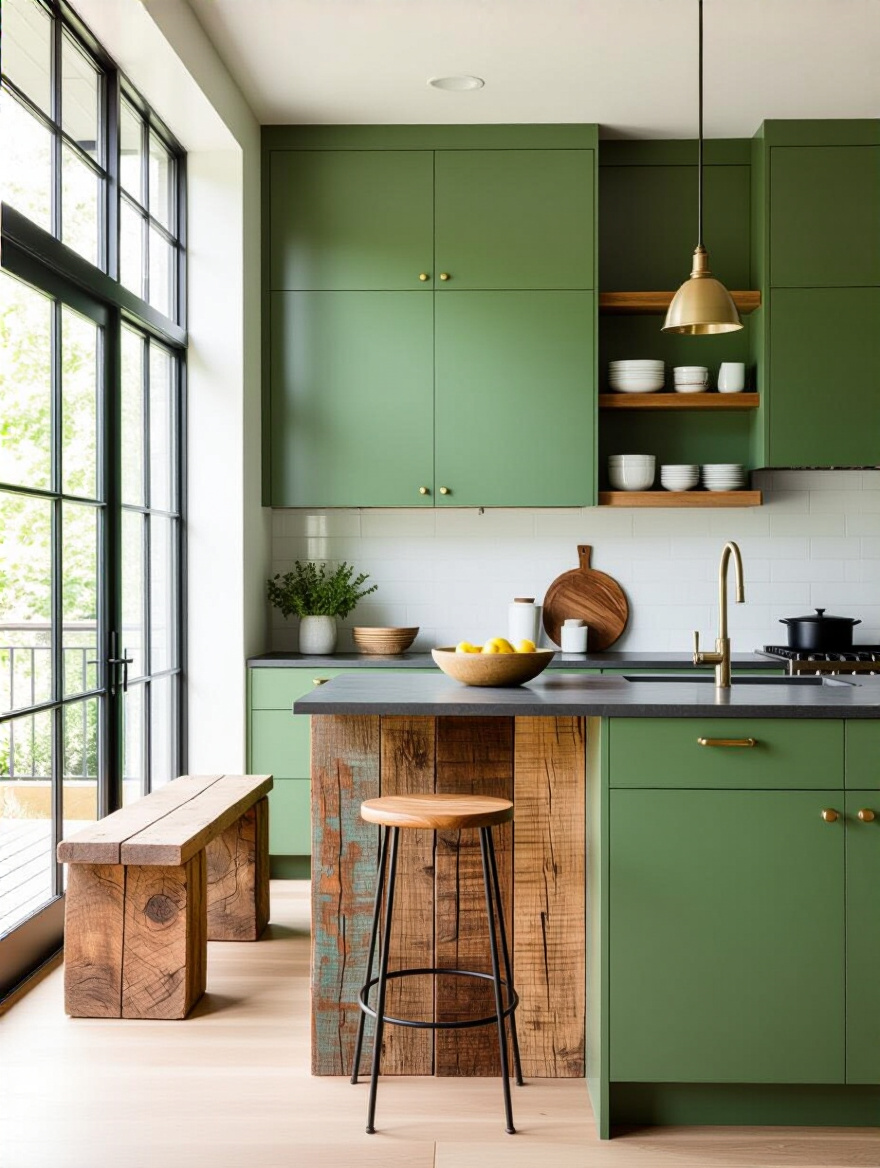
The BS people believe is that “reclaimed” is always rustic and shabby. It doesn’t have to be. Recycled-content countertops can look incredibly modern and polished. I worked with a client who found a gorgeous slab of marble at a salvage yard for a tenth of the price of new. It had one tiny chip in the corner that we were able to cut around easily. She saved thousands and got a completely unique centerpiece for her kitchen. The shortcut is to check out your local Architectural Salvage yards or Habitat for Humanity ReStore before you even step foot in a big box store.
These pieces give a kitchen soul. They give it a history that you just can’t buy off a shelf.
8. Opt for Non-Toxic Finishes: Ensure Healthier Indoor Air Quality for Family
This one is non-negotiable for me. The “new paint smell” or “new cabinet smell”? That’s the smell of chemicals called Volatile Organic Compounds (VOCs) off-gassing into your home. These things are linked to everything from headaches and allergies to more serious long-term health issues. Your kitchen is a sealed box, and what you put on your walls and cabinets stays in the air you breathe.
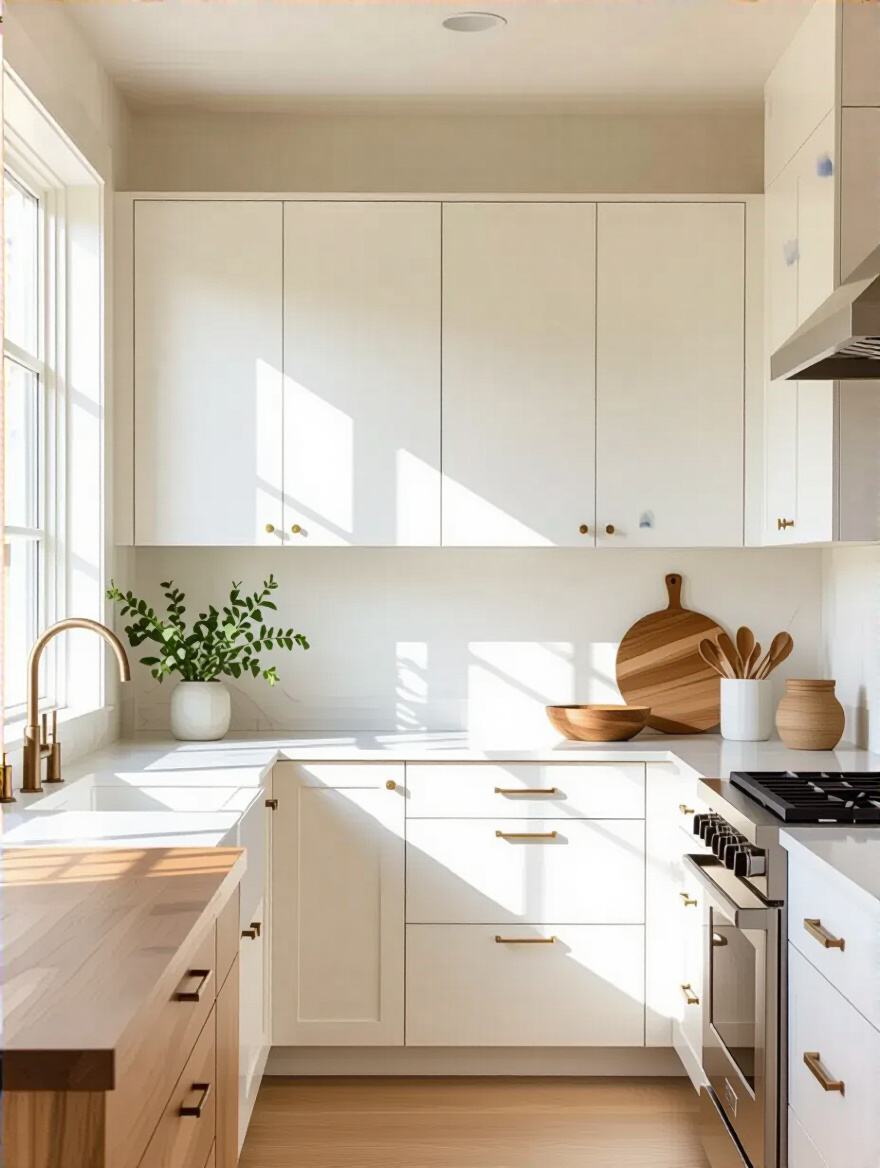
Look for paints and finishes that are labeled “No-VOC” or “Zero-VOC,” and double-check for that GREENGUARD Gold certification. This is especially important for cabinets, which have a huge surface area. A lot of cheaper cabinets are made with particleboard and glues that are loaded with formaldehyde. I confess, early in my career, I didn’t pay enough attention to this. I specified a sealant for a client’s reading nook, and it took weeks for the smell to dissipate. I learned my lesson: always check the label, always prioritize air quality. Your family’s health is worth it.
It’s an invisible upgrade, but it might be the most important one you make.
9. Invest in Energy-Star Appliances: Slash Utility Bills and Carbon Emissions
We’ve touched on this already, but it’s worth its own point because it’s so important. Your appliances are the engines of your kitchen, and they can be either efficient powerhouses or ancient, gas-guzzling lemons. When it’s time to replace one, investing in an ENERGY STAR model isn’t just a “green” choice; it’s a smart financial one.

The blue ENERGY STAR label is your guarantee that you’re buying one of the most efficient products on the market. Yes, sometimes they cost a little more upfront. But people get stuck on that initial price and forget to calculate the long-term savings. The little yellow EnergyGuide label on the appliance will even tell you its estimated yearly operating cost. Use it! A fridge that’s $100 cheaper but costs you $50 more per year to run is a bad deal. It’s simple math, but we often forget to do it in the store. This is the definition of working smarter, not harder.
You don’t need to replace everything at once. Just follow the ‘Worst First’ rule and upgrade when your old appliances die.
10. Select Durable, Renewable Countertops: Ensure Longevity with Low Environmental Impact
Your countertops take a beating every day. Choosing a material just for its looks is a mistake I see all the time. The most sustainable choice is a countertop that will last for decades, so you don’t have to tear it out and replace it. Durability is sustainability. Things like stainless steel, certain natural stones, recycled glass, or even good old-fashioned wood that can be refinished are fantastic choices.
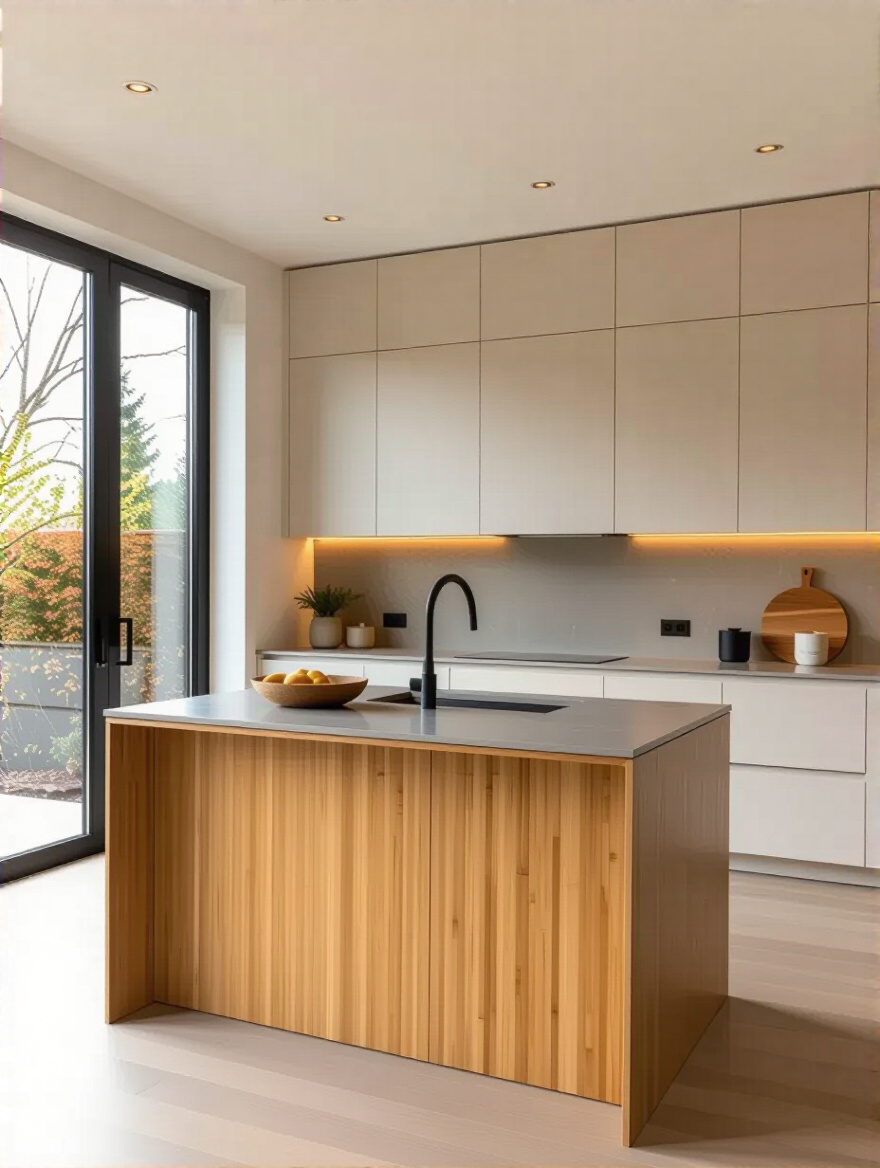
The BS here is the assumption that trendy equals good. That super-porous marble countertop that looks amazing on Instagram? It’s going to stain if you look at it wrong and require constant sealing with chemical products. The most valuable question you can ask is not “How does it look?” but “How does it live?” Ask about maintenance, sealing requirements, and how it handles heat and scratches. Choosing something durable saves you money, waste, and a ton of headaches down the line. It creates a kitchen that’s meant to be used, not just admired.
That same principle of durability and responsible sourcing applies to the biggest visual element in your kitchen.
11. Specify Sustainably Sourced Cabinetry: Support Responsible Forest Management Practices
Cabinets make up a huge part of your kitchen’s visual and physical space. Where that wood comes from matters. Choosing cabinets with an FSC certification means you’re not contributing to the destruction of vital forests. But just as important is what the cabinets are made of and held together with.
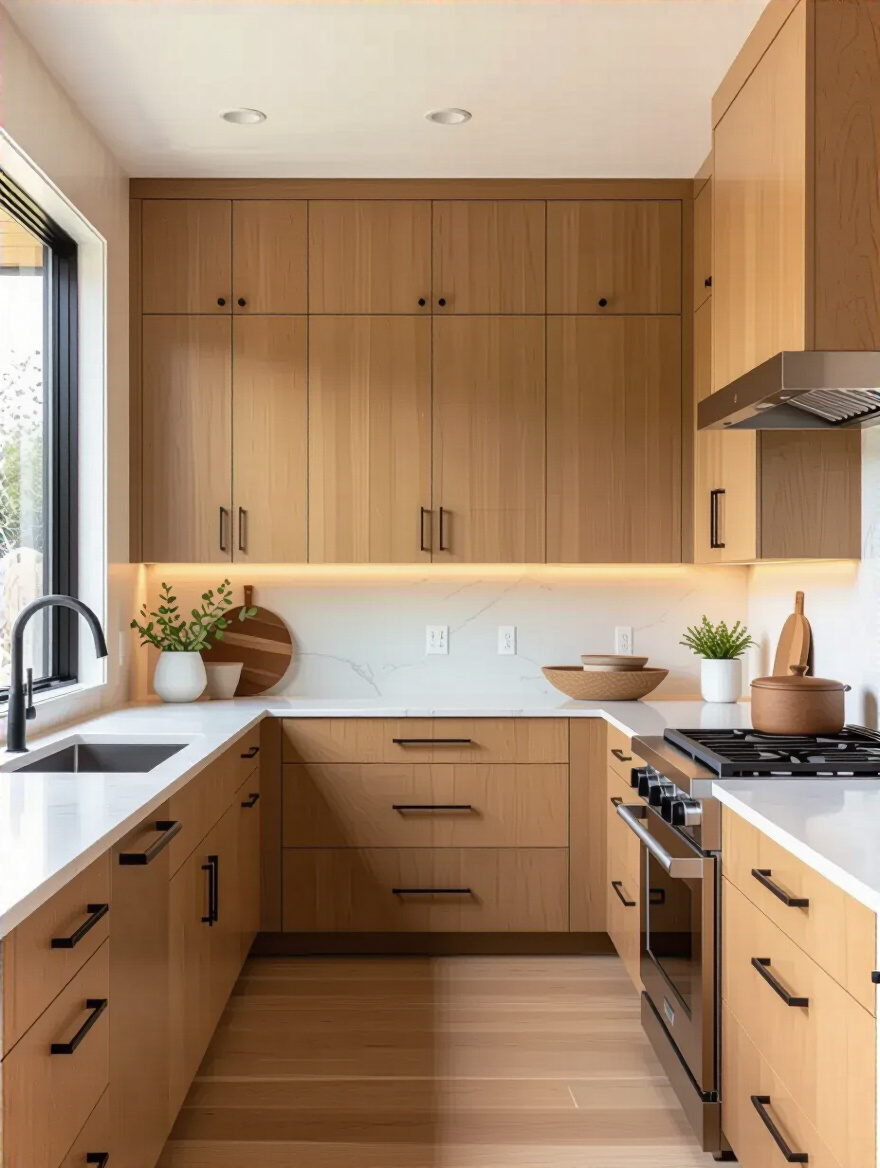
I once walked into a kitchen showroom, and the chemical smell from the adhesives in the particleboard cabinets was so strong it made my eyes water. This is the hidden trap. You can have beautiful wood doors on the front, but the cabinet boxes can be made of low-quality, formaldehyde-laden particleboard. This goes back to air quality. Always ask what the whole cabinet is made of and what kind of glues and finishes are used. Look for solid wood construction or high-quality plywood with no-added urea-formaldehyde (NAUF) adhesives. A good cabinet maker will be proud to tell you about their materials. If they get squirrelly about it, that’s a red flag.
Cultivating Eco-Friendly Kitchen Habits: Everyday Sustainability
You can have the most sustainable kitchen in the world, but if your daily habits are wasteful, you’re missing the point. This is where you see the biggest day-to-day impact.
12. Implement a Smart Composting System: Effortlessly Divert Food Scraps from Landfill
This is probably the single most impactful habit you can adopt. Food scraps sitting in a landfill release methane, a greenhouse gas that’s way more potent than CO2. Composting turns that waste into a valuable resource for your garden or houseplants. And before you say it’s gross or complicated, things have changed.

The new electric countertop composters are incredible. You toss in your food scraps, push a button, and a few hours later you have a dry, odor-free, nutrient-rich dirt. It’s magic. If you have a yard, a simple tumbler bin is easy. The key is just to start. A small countertop bin with a charcoal filter doesn’t smell. I pre-freeze my scraps in a bag in the freezer and dump them into the composter every few days. It completely eliminates fruit flies and any hint of odor. You will be absolutely shocked by how much this shrinks your weekly trash.
It’s a small change in routine that makes a massive difference.
13. Embrace Reusable Food Storage: Eliminate Single-Use Plastics Forever
Look in your drawers. How many boxes of plastic wrap, foil, and zip-top bags do you have? This is a constant stream of waste and expense. Making the switch to reusable storage is a game-changer. It takes a little adjustment, but it quickly becomes second nature.
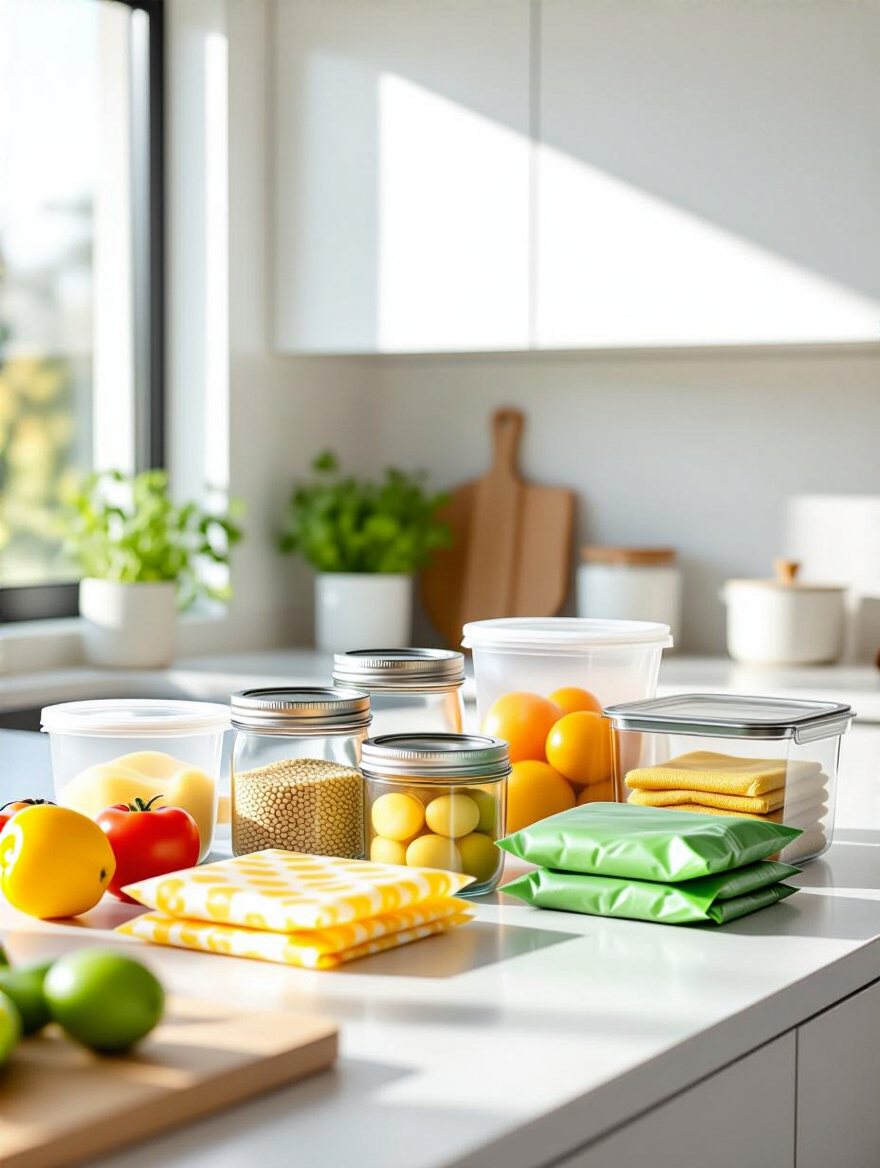
Start small. Get a set of glass containers for leftovers—they don’t stain, don’t hold odors, and can go from the fridge to the microwave. Buy a few silicone reusable bags for sandwiches and snacks. Invest in some beeswax wraps or silicone lids to cover bowls instead of using plastic wrap. My “hard way” story here was realizing how much money I was literally throwing in the trash every week on single-use bags. The upfront cost of the reusables pays for itself surprisingly fast. Plus, you’re not wrapping your food in plastics that can leach chemicals.
This isn’t about perfection. It’s about having the right tools on hand so that the sustainable choice is also the easy choice.
14. Strategic Meal Planning: Reduce Food Waste and Grocery Spoilage Significantly
Meal planning sounds like a chore for super-organized people, but I see it as a strategy for creating calm. It’s about reducing decision fatigue. When you know what you’re eating for the week, you eliminate that daily 5 PM panic of “What’s for dinner?” That alone is a huge mental win. The happy side effect is that you slash your food waste and your grocery bill.
The shortcut is the “Eat Me First” bin. Put a small basket in your fridge and fill it with anything that needs to be used up soon: half an onion, the last few mushrooms, yogurt that’s about to expire. When you’re making a meal, you check that bin first. This simple trick forces you to use what you have before it goes bad. It stops that slow, sad journey of fresh produce from the crisper drawer to the compost bin. A weekly plan, based on what’s in your fridge first, is the secret to a more organized mind and a fatter wallet.
And where you get that food matters just as much as how you plan to use it.
15. Shop Local and Seasonal Produce: Minimize Transportation Emissions, Boost Freshness
This is one of the most enjoyable habits to cultivate. Food that’s grown nearby and picked when it’s actually ripe just tastes better. It’s that simple. It hasn’t spent a week on a truck losing nutrients and flavor. Going to a farmers’ market connects you to your food and your community in a way that fluorescent-lit grocery aisles just can’t.
People sometimes think local and organic is always more expensive. It can be, but not always. And when you factor in the reduced waste—because the food is fresher and lasts longer—the costs often even out. The shortcut is to sign up for a CSA (Community Supported Agriculture) box. You get a weekly box of whatever is in season from a local farm. It forces you to get creative and try new things, and it’s an incredible value. It turns cooking from a chore into an adventure.
From shopping local to shopping hyper-local—let’s talk about your windowsill.
16. Create an Indoor Herb Garden: Enjoy Fresh Herbs, Reduce Packaging Waste
Have you ever bought one of those plastic clamshells of fresh basil for a recipe, used three leaves, and then watched the rest turn to black slime in your fridge? It’s the worst. An indoor herb garden completely solves this problem. It’s the ultimate in fresh, local, and package-free food.
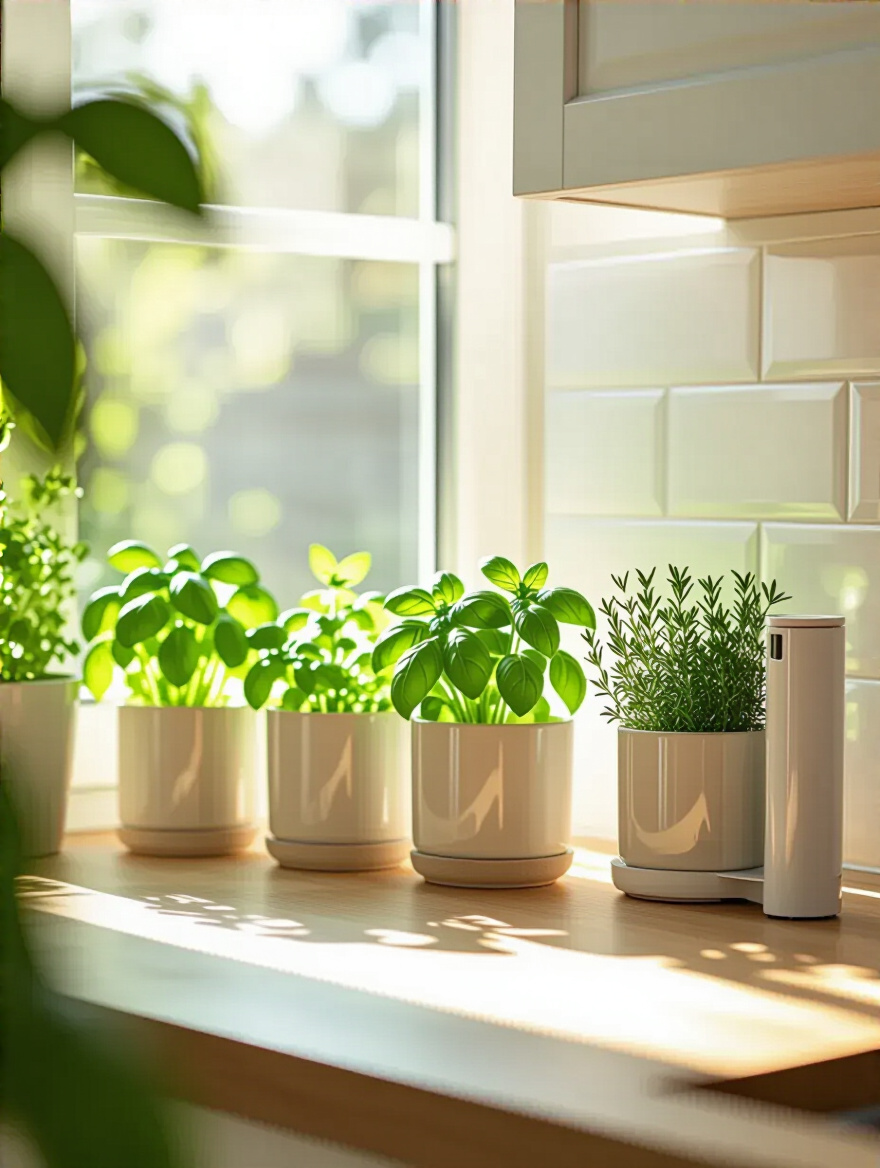
You don’t need a green thumb. Start with easy ones like mint, chives, or basil in a sunny window. Even if you have to supplement with a small LED grow light, the cost is minimal compared to the price of buying fresh herbs all the time. Snipping fresh herbs to throw on top of a meal makes everything taste more vibrant and intentional. It’s a tiny touch that elevates your cooking and eliminates a constant source of plastic waste and food spoilage. It’s a small, living thing that brings a little bit of nature and calm right into your kitchen.
Just as you bring natural things in, it’s equally important to keep toxic things out.
17. Make Your Own Cleaning Products: Avoid Harmful Chemicals, Reduce Plastic Bottle Waste
Walk down the cleaning aisle at the grocery store. The warning labels and overpowering artificial scents should tell you everything you need to know. Most of that stuff is a cocktail of harsh chemicals you don’t need, packaged in plastic bottles you’ll use once and throw away. The truth is, you can clean almost your entire kitchen effectively with just a few simple, cheap ingredients.
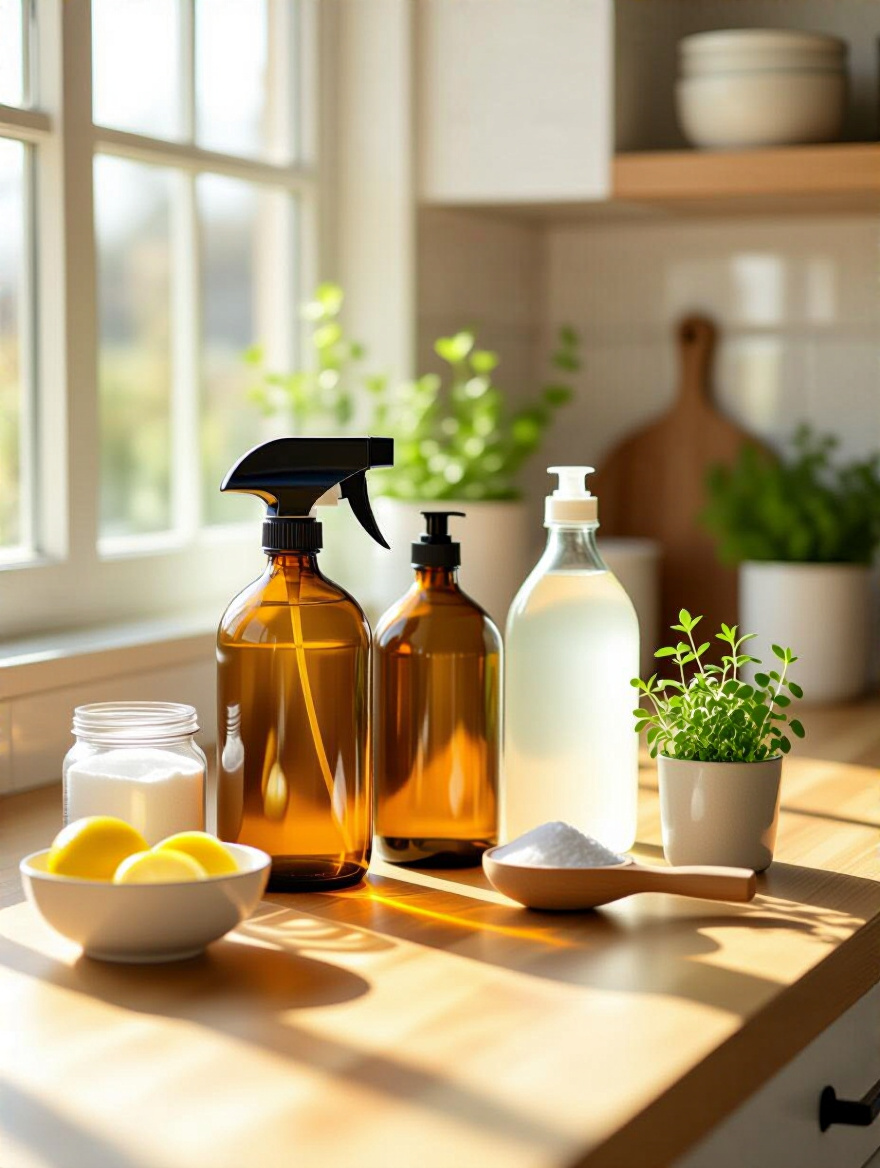
A spray bottle with equal parts white vinegar and water is a fantastic all-purpose cleaner and glass cleaner. A paste of baking soda and water is a great gentle scrub for sinks and stovetops. Add a few drops of lemon or lavender essential oil if you want a nice, natural scent. It is ridiculously cheap, it eliminates a ton of plastic waste, and most importantly, you’re not bathing your food-prep surfaces in mystery chemicals. This is a five-minute change that will make your kitchen healthier and save you a surprising amount of money.
Optimizing Resource Use & Waste Reduction: Smart Performance
This last part is about making your kitchen work for you. It’s about fine-tuning the daily operations to be as efficient as possible, so you’re not wasting resources without even thinking about it.
18. Install Low-Flow Faucets and Aerators: Conserve Significant Water Daily
This is one of the easiest, cheapest, and most impactful upgrades you can make. A low-flow aerator is a tiny screen you screw onto the end of your faucet. It costs about five dollars and takes two minutes to install. It works by mixing air into the water stream, so it feels like you have the same pressure, but you’re actually using about 30% less water.
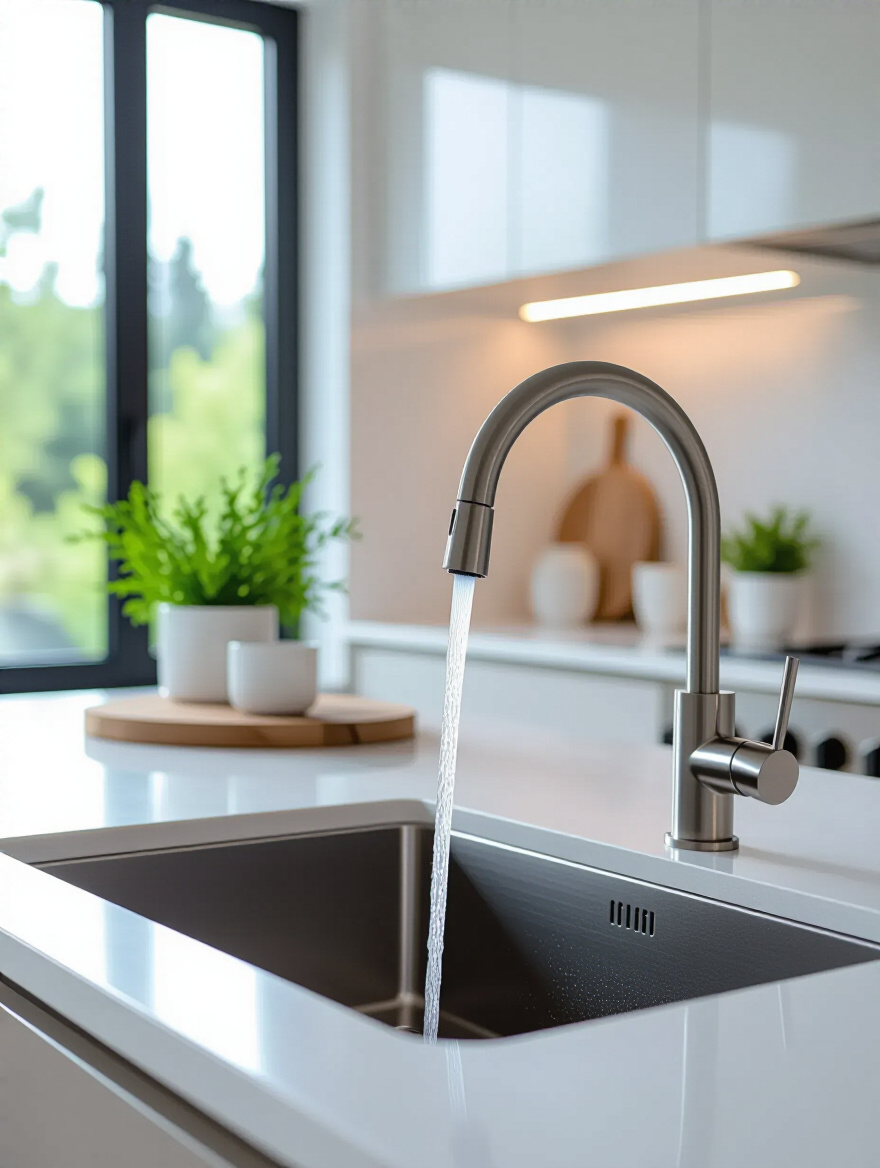
Think about how many times a day you run the water in your kitchen. All those saved gallons add up, both in your water bill and in the energy it takes to heat that water. This is a classic “set it and forget it” upgrade. You do it once, and it saves you money and resources every single day without you ever having to think about it again. The WaterSense label is your guide here. It’s the best five bucks you’ll ever spend on your kitchen.
From the sink to the dishwasher, the same principles of efficiency apply.
19. Efficient Dishwashing Practices: Run Full Loads, Air Dry for Energy Savings
This might sound like your parents yelling at you, but they were right. Running the dishwasher when it’s only half full wastes a huge amount of water and energy. Modern dishwashers are incredibly efficient—far more than handwashing—but only if you use them correctly. The golden rule is: always run a full load.
But here’s the pro tip that most people miss: skip the heated dry cycle. That heating element uses a ton of electricity. Instead, just open the dishwasher door a crack when the cycle is done and let the dishes air dry. It costs nothing and can cut your dishwasher’s energy use by as much as 50%. Also, you don’t need to pre-rinse your dishes obsessively. Modern dishwashers are designed to handle food particles. Scrape off the big stuff, but save the water and let the machine do its job.
These simple habit changes can save you a surprising amount on your utility bills each year.
20. Optimize Refrigerator & Freezer Use: Save Energy, Keep Food Fresher Longer
Your fridge is on 24/7, making it one of the biggest energy users in your home. A few simple tricks can make a big difference. First, get an appliance thermometer and make sure your fridge is between 35-38°F and your freezer is at 0°F. Even a few degrees off can make it work much harder. Second, check the seals. Do the dollar bill test: close the door on a dollar bill. If you can pull it out easily, your seals are leaking cold air and need to be replaced.
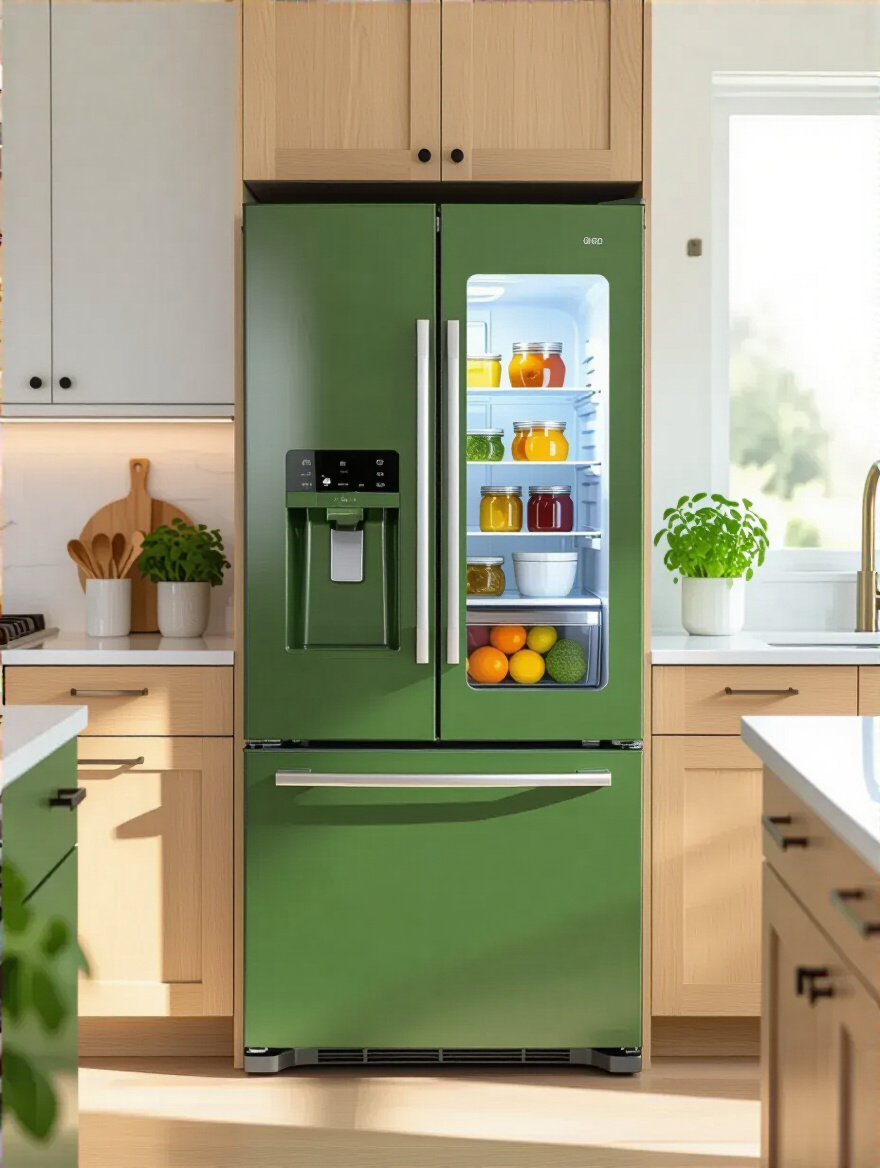
And here’s one people always forget: a full freezer is an efficient freezer. The frozen items help keep each other cold, so the freezer doesn’t have to work as hard when you open the door. If your freezer is half-empty, just fill up some empty space with water bottles. For the fridge, the opposite is true; it needs air to circulate, so don’t pack it too tightly. These are small adjustments that help your hardest-working appliance run more efficiently and keep your food fresh longer.
While your fridge keeps things cold, you can also be smarter about how you heat things up.
21. Cook with Lids on Pots: Retain Heat, Drastically Cut Stovetop Energy Use
This is so simple it feels silly, but the impact is huge. Putting a lid on a pot while you’re trying to boil water or simmer a soup traps an incredible amount of heat. It means your food cooks faster and uses way less energy. You can literally cut the energy needed to boil water by more than half just by putting a lid on it.
This is a habit I had to consciously build. We love to peek and stir. But every time you lift that lid, all the heat and steam escapes, and your stove has to work hard to build it back up. My shortcut is to use glass lids whenever possible. You can see what’s going on without letting all the energy escape. Once you get used to it, you’ll wonder why you ever cooked any other way. It’s faster, more efficient, and even keeps your food more flavorful and nutritious.
Finally, keeping those high-performing tools in good shape is the key to longevity.
22. Maintain Appliance Health: Clean Filters for Peak Efficiency and Lifespan
Your appliances are investments. You wouldn’t drive your car for years without changing the oil, but we often let our appliances run until they break. A little bit of simple maintenance can dramatically extend their life and keep them running efficiently. It’s about preventing problems before they start.
The two most-neglected spots are the dishwasher filter and the refrigerator coils. The dishwasher filter (usually a little basket at the bottom) catches food gunk. If you don’t rinse it out every few weeks, your dishes won’t get as clean, and the pump has to work harder. The refrigerator coils (at the back or bottom) get covered in dust and pet hair, which forces the fridge to use more energy to stay cool. Just vacuuming them once a year can improve efficiency by 10%. It’s a boring ten-minute job that saves you money and prevents a costly repair call down the road.
And for the last step, let’s make sure all your hard work doesn’t end up in the wrong bin.
23. Set Up Comprehensive Recycling Bins: Simplify Waste Separation for Maximum Diversion
After all this effort, the final step is to make it easy to do the right thing. If sorting your trash is a hassle, you won’t do it consistently. The solution is to create a dedicated, well-labeled “waste station” right in your kitchen. This isn’t just one recycling bin; it’s a clear system for everything.
Invest in a good pull-out or stackable system with separate compartments for landfill, mixed recycling, and compost. Label them clearly. When it’s just as easy to toss a banana peel in the compost bin as it is to throw it in the trash, your habits will change on their own. The goal is to make the sustainable path the path of least resistance. This simple, organized system is the final piece of the puzzle, turning your intentions into effortless, everyday action.
Conclusion
Creating a green kitchen isn’t a weekend project; it’s a shift in mindset. It’s about seeing this central space not as a source of chores and waste, but as a powerful engine for a calmer, healthier, and more productive life. It’s about understanding that saving energy saves you mental energy. That reducing waste reduces financial stress. That using non-toxic materials creates a sanctuary for your family.
Don’t try to tackle all 23 of these things at once. Just pick one. Start with the one that feels easiest or most impactful to you. Maybe it’s just putting a lid on your pot tonight. Or buying a five-dollar aerator for your faucet. Every small, conscious choice builds momentum, making your kitchen, and by extension your entire home, a place that truly supports and nurtures you. It’s about building a better future, one mindful meal at a time.






